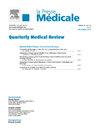Pituitary organoids as models for congenital pituitary deficiencies
IF 3.4
3区 医学
Q1 MEDICINE, GENERAL & INTERNAL
引用次数: 0
Abstract
Pituitary deficiencies, or hypopituitarisms, are defined as insufficient production of one or more adenohypophyseal hormones (growth hormone, TSH, ACTH, LH-FSH and prolactin). Congenital hypopituitarism, a rare disease with severely disabling consequences, often takes the form of isolated hormone deficiencies, such as isolated growth hormone deficiency (GHD) or isolated ACTH deficiency (ACTHD), or combined pituitary hormone deficiencies (CPHD), when several pituitary hormones are affected. They are mainly the result of genetic mutations, developmental malformations or the harmful action of environmental factors during foetal development. The last two decades have seen the emergence of new in vitro models called organoids, which make it possible to partially recreate the development of an organ using pluripotent cells. Using human embryonic stem cells (hESCs) or induced human embryonic stem cells (hiPSCs), it has been possible to recreate various stages of hypothalamic-pituitary development, a complex mechanism requiring interaction between two embryonic structures of different origins, right up to the production of functional pituitary endocrine cells. Coupled with techniques for reprogramming patients' somatic cells, these organoids have made it possible to understand the cellular and molecular mechanisms leading to the pathogenicity of a mutation in the OTX2 gene, identified as being responsible for CPHD. Using the CRISPR-CAS9 gene-editing technique, they have also demonstrated that the endocrine phenotype of patients suffering from DAVID syndrome is indeed linked to a mutation in the NFKB2 gene, thereby identifying this gene as a central element in pituitary development. Finally, the ability of these organoids to present a secretory response to hypothalamic stimulation and the possibility of modulating these signals by mimicking feedback from the target organs suggest that they could be used therapeutically.
垂体类器官作为先天性垂体缺陷的模型。
垂体缺陷或垂体功能减退症被定义为一种或多种垂体激素(生长激素、TSH、ACTH、LH-FSH和催乳素)分泌不足。先天性垂体功能低下是一种罕见的疾病,具有严重的致残后果,通常表现为孤立性激素缺乏,如孤立性生长激素缺乏症(GHD)或孤立性ACTH缺乏症(ACTHD),或合并垂体激素缺乏症(CPHD),当几种垂体激素受到影响时。它们主要是胎儿发育过程中基因突变、发育畸形或环境因素有害作用的结果。在过去的二十年里,我们看到了被称为类器官的新型体外模型的出现,这使得使用多能细胞部分地重建器官的发育成为可能。利用人类胚胎干细胞(hESCs)或诱导人类胚胎干细胞(hiPSCs),已经有可能重建下丘脑-垂体发育的各个阶段,这是一个复杂的机制,需要不同来源的两个胚胎结构之间的相互作用,直到产生功能性垂体内分泌细胞。再加上对患者体细胞进行重编程的技术,这些类器官使人们有可能了解导致OTX2基因突变致病性的细胞和分子机制,该基因被确定为CPHD的罪魁祸首。利用CRISPR-CAS9基因编辑技术,他们还证明了患有DAVID综合征的患者的内分泌表型确实与NFKB2基因的突变有关,从而确定该基因是垂体发育的核心因素。最后,这些类器官对下丘脑刺激产生分泌反应的能力,以及通过模仿目标器官的反馈来调节这些信号的可能性,表明它们可以用于治疗。
本文章由计算机程序翻译,如有差异,请以英文原文为准。
求助全文
约1分钟内获得全文
求助全文
来源期刊

Presse Medicale
医学-医学:内科
自引率
3.70%
发文量
40
审稿时长
43 days
期刊介绍:
Seule revue médicale "généraliste" de haut niveau, La Presse Médicale est l''équivalent francophone des grandes revues anglosaxonnes de publication et de formation continue.
A raison d''un numéro par mois, La Presse Médicale vous offre une double approche éditoriale :
- des publications originales (articles originaux, revues systématiques, cas cliniques) soumises à double expertise, portant sur les avancées médicales les plus récentes ;
- une partie orientée vers la FMC, vous propose une mise à jour permanente et de haut niveau de vos connaissances, sous forme de dossiers thématiques et de mises au point dans les principales spécialités médicales, pour vous aider à optimiser votre formation.
 求助内容:
求助内容: 应助结果提醒方式:
应助结果提醒方式:


